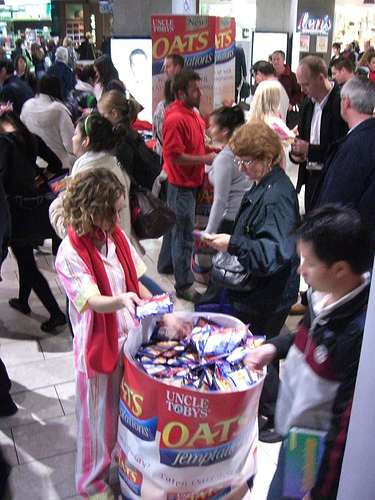
There has been a lot of news about Sam’s Club outsourcing product demos (see article by Chris Burritt at Bloomberg for just one of many examples). I read a quote in that article with which I don’t entirely agree: “Sampling mitigates risks for brands,” says VP and GM Brian Pear. “It’s less risky for mom because she’s able to sample it for free.”
Having reviewed and analyzed the sales data for 100+ retail brands over the past four years, I have to say that this simply is not true for all brands and all situations. There are a lot of factors necessary for an in-store sampling experience to directly create incremental sales.
Check Your In-Store Inventory
It may sound basic, but the first thing you need to ensure is that you have adequate inventory to support any immediate increase in off-the-shelf sales. It’s not uncommon for an in-store demo or sampling program to stock the event set with inventory from the shelf, therefore, leaving the shelf itself bare.
More than once I’ve looked at sales volume data, subtracted what the demo staff bought, and discover that there was nothing left. If the brand and the store’s buyer are not prepared before hand, there won’t be enough inventory to support the event, and the whole thing will be a flop.
Don’t Ignore Product Use Cycles
The consumer use cycle also needs to be considered. Household products tend to have a longer purchase cycle than food items. For instance, a consumer is less likely to buy paper towels than frozen peas after a demo. This doesn’t mean that there won’t be an uptick in sales. It just tends to be happen after the demo has been completed, often on the next regular stocking-up trip for the consumer.
Brands tend to want to analyze the data immediately after a demo. Sometimes you have to wait 30, or even 45, days to get a true measure of the impact. Product use cycles prove the axiom that “cause and effect are not always closely related in time and space.”
Use cycle is also impacted by the volume of units typically sold and demonstrated. If the demo is for a product that typically contains 30 items and average use is one item per day, sales may not increase for 15 to 30 days.
Watch For Product Hoarding
Even if you do find an uptick in sales, it’s not always a good thing. There are three possible reasons for incremental sales. You either attracted new consumers to the category, won over customers from a competitor, or your current customers are hoarding. The first two are desired results; the third, not so much. Bringing new customers to the category or winning over a competitor’s customers is great. Hoarding can be a problem.
Hoarding is when a customer buys more of a product on sale yet avoids buying down the road because they’ve already “stocked up.” This is obviously more common for products with longer shelf lives (e.g., cleaners, dry food items, etc.), but less common for products that are bulky (e.g., diapers, paper products, etc.).
Sometimes what may appear as hoarding is really increased consumption.
Juice is a great example of a product that is subject to increased use. While someone isn’t likely to increase their use of butter (unless educated about new uses), many drink products, like juice, milk, and alcohol can appear by the data to be hoarding, but may really represent an increase in short-term usage. The consumer will return to normal (or slightly increased) consumption patterns once the discounted or sampled supply has been consumed.
So, yes, sampling and in-store demonstrations can be a great marketing tool for CPG brands. However, if you don’t have the right analysis strategy in place, you will never fully understand if what you did worked or why.
